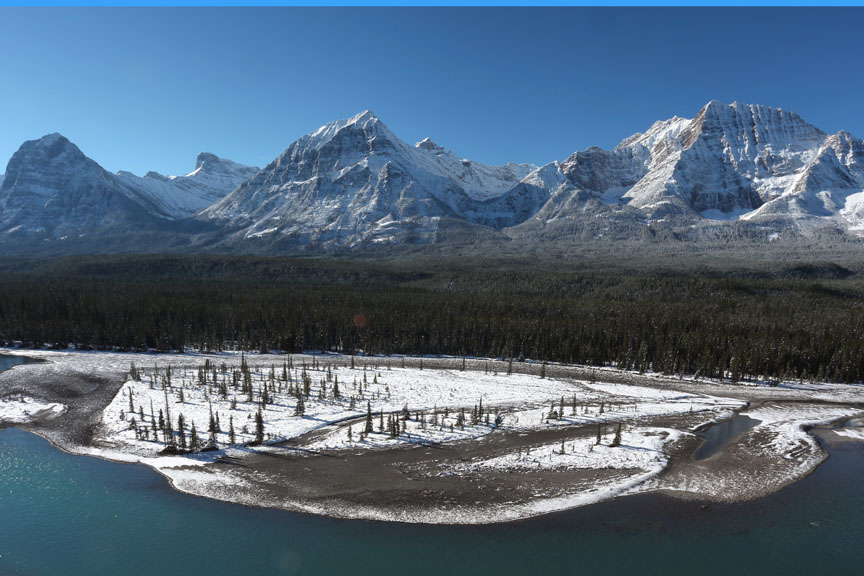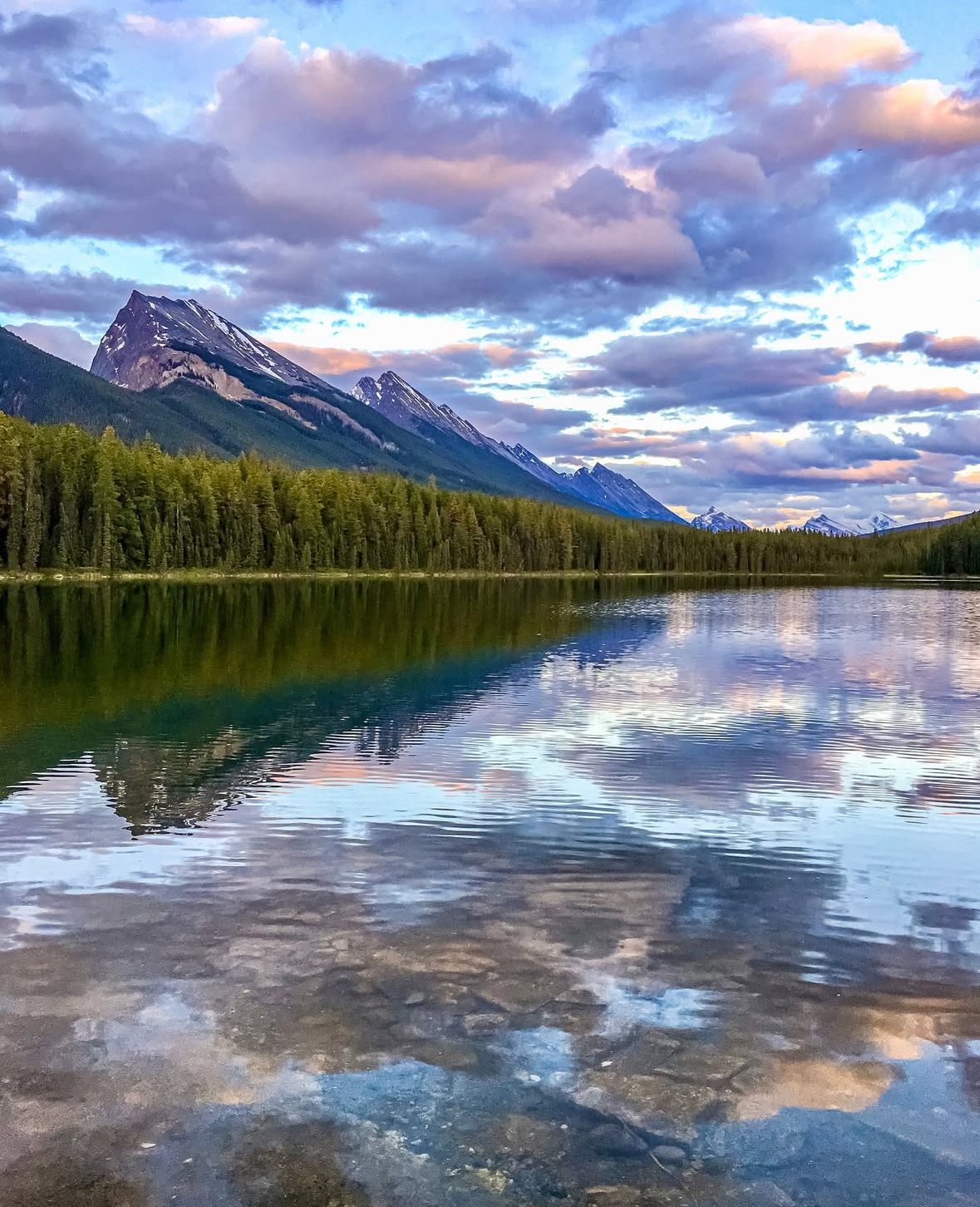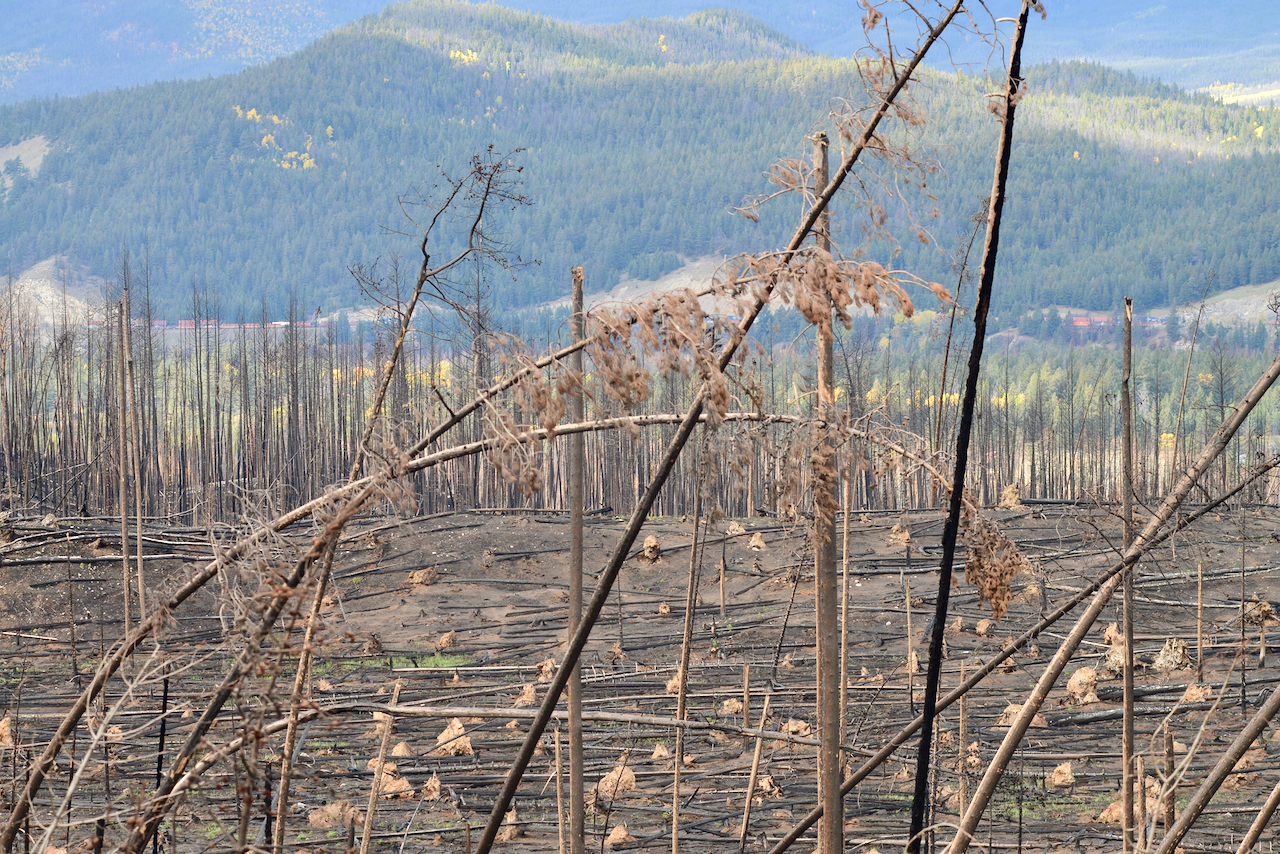“Returning to Jasper this summer, I found myself rerooting, as an Albertan who spent most of my adult life abroad.”
The palette beyond our engine was a blinding white.
Not snow, not fog, but something closer to the emptied light that those who brush against death claim to glimpse — a blankness that swallowed the boogie van and its jangling load of gear crammed behind our seats like the sudden crest of a bad trip. The world vanished, and the van rattled forward into nothingness. The snow snakes that first slithered across the two-lane highway past Hinton now thickened into a burial shroud, a cairn laid over asphalt. Somewhere to the right, the Athabasca River carved black water through the wide, flat-bottomed valley; somewhere to the left, its back eddy ponds waited under a thin layer of ice. Our only commandment was simple: stay on the uncertain strip in between.
At a sharp bend behind which bighorn sheep often loiter, the bass player’s knuckles blanched into bone on the wheel. He didn’t glance at us when he muttered something of a prayer, “Bambi might be waiting out there, but something bigger has its claws on the van. It’s not me driving. It feels like I’m piloting a curling rock!”
That sensation of being slid by an unseen force across a vast, dangerous sheet of ice never truly faded. It’s the feeling these mountains impart. The Canadian Rockies don’t build roads so much as they tolerate them, thin scars carved into a body that can shrug us off without notice. The highways that thread these mountains carry their own moods, as alive as the rivers they shadow. Winter makes them gladiatorial, where serenity and menace grapple on black ice, but summer — summer reveals the mountain’s softer disposition. They unspool like a promise, but each curve carries the weight of an ambush, as if the mountains are only lending you passage until they decide otherwise. These geologically youngish crags suffer roads the way they suffer weather: temporarily. Snow buries them, rockslides shave them, and fire, always waiting in the timber, takes its natural turn in due season.

Thirty years on from that reckless Christmas gig at the Athabasca Hotel in Jasper, the highway into the park still carried its end-of-the-line gravity. The scenery outside the window remains the absolute protagonist, vast and indifferent, while the road itself still clung like a temporary accessory beside the waterways. I had returned to the mountains of my youth to see what three decades (and a global tourism boom) had done to the Canadian Rocky Mountain Parks World Heritage Site, made up of the chain of contiguous national parks — Banff, Jasper, Kootenay, Yoho, with Mount Robson, Mount Assiniboine, and Hamber at their margins, together forming a preserve vast enough to outsize nations like Israel and Djibouti.

At the entrance, the Parks Canada beaver logo may have shed the 70s swagger I remember, but the heritage-green signs have resisted the churn of fashion, standing as unyielding as the spruce they’re nailed against. They are relics of stasis in a place that sells itself as wilderness in motion, projecting permanence even as glaciers retreat and rivers redraw their courses. Their bilingual solemnity feels almost ceremonially colonialist, planted on First Nations land with older names still alive, while the bulk of the tourists snapping photos come not from Quebec but from across the Pacific. The signs endure, mute and immovable, even as the crowds and the climate shift around them.

Yet the secret is out.
In Western Canada it’s possible to experience the most awesome (used correctly here) wildlife vistas on earth without so much as unbuckling your seatbelt or leaving the faux-wood paneling of a rented motorhome that wobbles southward like a poorly driven modern pack mule. These roads delve deep into the most incredibly pristine wilderness around, with each pass and valley promising something more impressive than the last. In the Rockies, awe comes standard with the rental car, no upgrades required.

Between Jasper and Banff, the road itself is the expedition. What was once the kind of grandeur earned by weeks of trudging through snowfields and sleeping rough beneath spruce now presents itself through a pane of glass. The highway trespasses where only trails once wound, offering an intimacy with glaciers, rivers, and high meadows that feels almost undeserved. Each bend discloses a new astonishment…a valley cut deep as scripture, a fading glacier spilling like frozen breath down the scree, a bull moose stepping from the thicket as if on cue. So many photo-ops abound that you risk exhausting not your legs, but your phone’s memory, especially given the patchy and often non-existent mobile coverage.

What was once a campaign is now passage, and wonder arrives as effortlessly as the turn of a key. Throughout the two-lane corridor, glaciers, turquoise lakes, and elk herds appear in sequence like stations on a pilgrimage. The paradox is plain: some of the most breathtaking wilderness on earth has been made easy. Magnificence has been paved and painted, with frequent pull-outs, and opened to traffic.
But for all its grandeur, the illusion of permanence is paper-thin. These same roads that make transit painless can close in an instant, the mountains reclaiming what they had only lent. On July 22, 2024, the curtain dropped: flames rose 100 metres in the air from the valleys with the speed of a living thing, leaping from the transfer station to the campgrounds within the hour. By nightfall, the separate blazes had fused into a single firestorm — a monster that scorched 32,500 hectares of national park and consumed nearly a third of the town of Jasper itself.

Jasper has always been Banff’s country cousin — smaller, rougher around the edges, and a longer haul from any big city. While Banff rolled out the red carpet for movie stars and tour groups straight off flights from Tokyo, Jasper catered to railway workers, outfitters, and families who drove up in rusted pickups. Banff poured cocktails beneath chandeliers; Jasper’s Atha-B hotel served draft beer in pitchers sticky with condensation, and its crowd only slowly gave way to the pint-glass era. Where Banff glittered with a kind of alpine opulence, Jasper wore its parka indoors and smelled faintly of woodsmoke and spilled lager. More fur trapper than gold digger.

As you pull into town today, rows of temporary housing line the road like shipping containers that tumbled off the back of a truck, a reminder of how impermanent most North American buildings feel against the immutable weight of these mountains. More than 350 structures were lost in the blaze, a third of the town reduced to smoldering rubble. Fire moved like a beast; recovery moves like paperwork: soil tests, insurance claims, permits… Families wait. Some make do in trailers, others hold out for stability that feels further away than the peaks themselves.

Jasper is not a typical Canadian town. It exists inside the fence line of a national park, a specialized municipality where the Crown owns every acre and residents hold only the homes they build upon it. That odd impermanence, the sense of renting space from the country itself, feels sharper now. True, the government has poured hundreds of millions into recovery, but the scars remain raw, and the town wears its displacement openly. On signs around town, visitors are advised to ask about the park, the town, the people — but not about what was lost.

On the road east out of town towards Maligne Lake and its oh-so-Instagrammable Spirit Island, the scale of the devastation widens. Lodgepole pines stand like blackened uprights in a wasted orchestra pit, their limbs burned to useless stubs pointing nowhere. What fire did not consume, wind flattened, and the valleys echo with gusts unbroken by forest. Yet among the charred and broken matchsticks, wildflowers bloom in profusion. Hikers still crowd the popular Skyline trailhead, most of which runs at or about the treeline, and its parking lot overflows. From the ruin, new vistas have opened up and mountains revealed where trees once obscured them. The landscape has been stripped back to its bones and, paradoxically, made more legible. The backcountry was fortunately spared; most trails remain open, winding past charred timber into untouched meadows already bright with flowers.

South of town, the scars deepen. The fire’s greatest bite was in the Valley of the Five Lakes. Between the sentinels of Mount Tekarra to the east and The Whistlers to the west, a cradle of forest now stands, charred and raw. Beyond that valley the road lifts its gaze south, onto the 232-kilometre ribbon that links Jasper to Lake Louise. The Icefields Parkway: a name that promises grandeur and delivers it in excess. Here the highway straddles the continental divide, stitching together two provinces, two watersheds, and two visions of the Rockies — the raw resilience of Jasper behind you, the polished opulence of Banff waiting ahead.

The Icefields Parkway is billed as the most beautiful drive on earth, and it probably is. Glaciers that 30 years ago crept toward the road now retreat into the peaks, lakes glow in preternatural shades of blue, and the wildlife often shows up on cue. Sublimity is easy here, as easy as shifting into cruise control. Yet the ease of it all is disorienting, all this majestic splendor delivered through your window like a drive thru. But that is the sleight of hand: what as recently as 1940 demanded weeks of hunger and hardship now arrives through your windshield, souvenir-ready at every lay-by.
Southbound, Jasper’s burnt edges fade in the rear-view mirror and Banff’s serene slickness looms ahead. Proof that even such untamed wilderness can be paved, packaged, and delivered with cup holders and then shakily driven south in rented RVs that lumber from pullout to pullout like mobile chalets.

Still, beneath the spectacle, today’s truth remains unchanged: the glaciers are retreating, the forests will burn again, and the road itself is no more permanent than a snow track across stone. The mountains remain impassive in their insouciance, granting passage only until they decide otherwise. In the end, the Rockies prove that Canada’s greatest roadside attraction is not a world’s-largest anything, but the sheer absurdity of awe delivered at 90 kilometers an hour… just as if you were steering a curling rock through the sublime.
Troy Nahumko // info@thejasperlocal.com
Troy Nahumko is a Canadian writer based in Spain. Find his work at troynahumko.com


